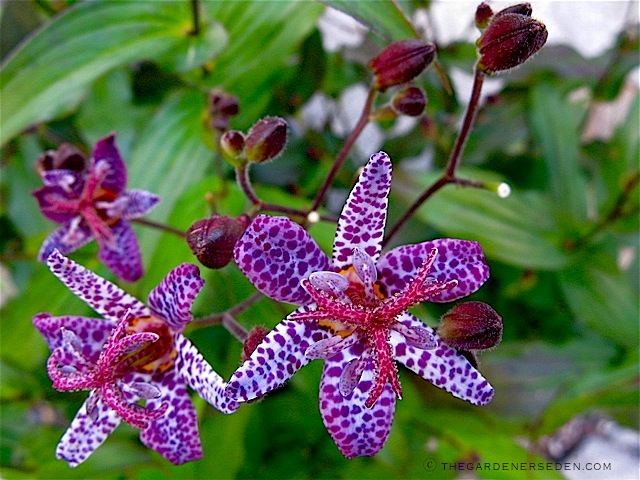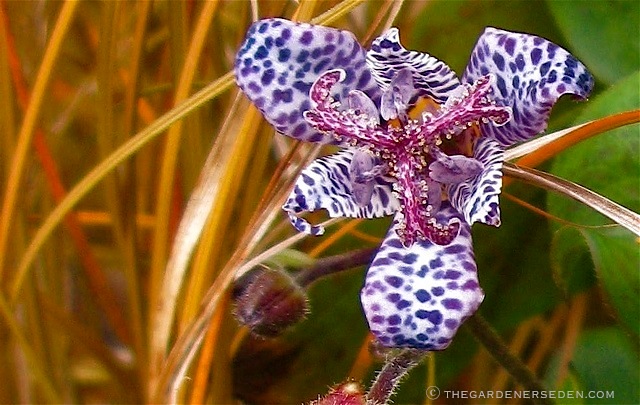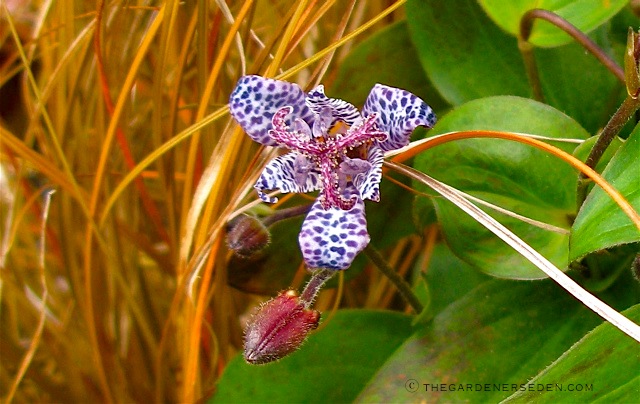Tricyrtis formosana ‘Dark Beauty’ ….. The Late Blooming Perennial Toad Lily
 Tricyrtis formosana ‘Dark Beauty’ in the Secret Garden at Ferncliff
Tricyrtis formosana ‘Dark Beauty’ in the Secret Garden at Ferncliff
The first time I encountered Tricyrtis formosana she had been stripped of all foliage and was displayed dramatically with coppery toned twigs in a Japanese vase. It was lust at first sight. I was standing at the front desk in an elegant hotel lobby, and although I had plenty of things on my mind, I was driven to distraction by this flower. I suspected this was no orchid, but I could not identify her. Completely possessed, I had to know everything about the plant immediately. I peppered the hotel manager and staff with questions, and of course, no one could help me. In fact, I am certain the concierge thought me quite mad. He was busy and completely indifferent to my horticultural distress.
So I lurked about the first floor of the hotel, lingering in the bar with a late afternoon libation until the uncooperative employees departed. When the hotel staff changed shifts, a sympathetic face appeared behind the long slab of marble and I seized the opportunity at hand. This time I carefully tempered my enthusiasm so as not to appear too odd, and I simply inquired about the hotel’s florist. Much to my delight, after disappearing around the corner, the rather dashing fellow returned with a business card. “They are open tomorrow until noon”, he said. It was then that he must have noticed my aching gaze toward the vase, for he said… “Wait here just a moment”, and he disappeared once more. “Here…”, he smiled conspiratorially and presented me with three gorgeous stems, “These were on my boss’ desk”, he said, “and she has gone for the weekend”. I offered him a tip but he waved his hand. “My mother is obsessed with flowers, I understand”.
When the florist’s shop opened the next day, I learned that the object of my infatuation was a cultivar of Tricyrtis formosana. And although she may look like a member of the orchid family, she is not. Her swollen buds and speckled, waxy petals do bear a striking resemblance to Cymbidium, or perhaps Phalaenopsis, but her alternate lance-shaped leaves and hairy stems are a dead give away. This dappled beauty is actually a lily. A toad lily, in fact. And although I do find warty amphibians quite charming, I think this name is completely unsuitable. Other than Tricyrtis’ preference for a moist location, there is nothing toad-like about this elegant plant.
 Tricyrtis formosana ‘Dark Beauty’ and Uncinia egmontiana, (orange hook sedge)
Tricyrtis formosana ‘Dark Beauty’ and Uncinia egmontiana, (orange hook sedge)
This initial introduction to Tricyrtis formosana was some years ago, before I finished college. When I finally had a garden of my own I was back in New England and Tricyrtis formosana was nowhere to be found. Although I heard there were hardier cultivars, (most range-out at zone 6), I could not find one to match the beauty I met in the hotel that day. Time went by, and I moved on to other botanical loves, but I never forgot my “orchid-lily”.
I shop around quite a bit for plants every year, and I try to keep an open mind when it comes to sources. You never know. Sometimes the most unusual things will turn up at a garden swap, or even a yard sale. I am no shop-girl snob, and I am certainly not above looking for botanical treasures in the most common of places. But I have to admit I was taken aback when I ran into my old love at the Home Depot. Of all the box stores in all the towns in all the world…
There she was, Tricyrtis formosana, the ‘Dark Beauty’. Â Needless to say she came home with me. Native to Japan, this lovely lily brings a touch of exotic, Asian elegance to my shady northern nook. Much to my delight, this cultivar is hardy in zones 4 – 8. Â She likes partial shade and constant moisture, and when happy her rhizomatous roots will spread out to form 2 to 3 foot colonies. Best of all, the ‘Dark Beauty’ blooms in early to mid fall, when few other flowers remain in my garden. I believe she likes taking the stage all to herself in the late show. And I am more than happy to supply her with a vibrant supporting cast.
The bold orange tones of Japanese forest grass, Hakonechloa macra ‘Nicolas’, strike a beautiful, contrasting chord when positioned beside the violet hues of Tricyrtis formosana ‘Dark Beauty’. A similar effect may be achieved when she is combined with orange hook sedge, (Ucinia egmontiana). Although you might not expect a dramatic late season finale when the pair are viewed throughout the quiet days of summer, ‘Dark Beauty’ will stand out in bold contrast to the orangy-gold autumn color of  our native cinnamon fern, (Osmonda cinnamonea), in fall. Tricyrtis formosana reaches a height somewhere between 18 and 28″, and she combines beautifully with other perennials. I might choose coral bells (Heuchera), for the foreground and perhaps position her beside a dark violet monkshood, (Aconitum, various cultivars), to create a dramatic autumn vignette. Her glossy green leaves play nicely against the feathery foliage of Astilbe, or the statuesque Goat’s Beard, (Aruncus dioicus), who backs up ‘Dark Beauty’ particularly well.
So here we are together again. Me and my old flame Tricyrtis formosana. So why not play it Sam? This looks like the beginning of a beautiful friendship …
 Tricyrtis formonsana ‘Dark Beauty’ with Orange Hook Sedge
Tricyrtis formonsana ‘Dark Beauty’ with Orange Hook Sedge
***
Article and Photographs copyright 2009, Michaela at The Gardener’s Eden
All content on this site, (with noted exceptions), is the property of The Gardener’s Eden and may not be used or reproduced without prior written consent. Inspired by something you see here? Great! Please give credit where credit is due. It’s a small world and link-love makes for fond friendships. Stealing makes for bad dreams…
Do you enjoy visiting The Gardener’s Eden? You can help support this site by shopping through our affiliate links. A small percentage of any sale originating from The Gardener’s Eden site will go toward web hosting and maintenance costs. Thank you for your support!
3 Replies to “Tricyrtis formosana ‘Dark Beauty’ ….. The Late Blooming Perennial Toad Lily”
Comments are closed.


so happy i’ve stumbled upon your site – it’s beautiful and so informative for a fellow gardener!
Thank you so much for your kind words, and for visiting the site. I am glad you enjoy it and I hope you will come back soon. Your photography is beautiful. And most important, congratulations to you on your recent marriage.
All the best,
Michaela